Final report for FNC22-1333
Project Information
The specialty crop enterprise covered 4 different spaces on our rotational grazing cattle/sheep operation. Livestock have been grazing on these areas for 10 years. Two of the spaces were established with 4-7x7x3 square bales. One space was created with 10-7x7x3 square bales. The last space was created with 2-5x5 round bales. The spaces created with square bales were out in a paddock that was winter bale-grazed, the space created with round bales was in the sacrifice paddock where the cattle were fed from February-May.
A common practice for livestock producers in northern climates is setting out bales of hay and "bale-grazing" through the winter months. These bales leave behind organic matter that is great fuel for the soil. However, these areas are often unproductive in the first season after feeding because the residue mulches the ground, suppressing growth for several months until it breaks down.
This weed suppression is a prime opportunity to transplant some high-value specialty crops into a space where they don't have to compete for sunlight or other nutrients. A handheld drill auger attachment quickly makes an opening large enough for a started plant's roots without the need for conventional tillage or chemical burndowns. While the hand-planting could limit scaling, the reduction in weeding, labor, and chemical inputs should offset the additional planting labor.
Producing a high-value crop on land that would've been mostly unproductive through the growing season can diversify income sources and provide the farmer and their community with additional local food choices. Our goal is to identify which specialty crops respond well to this growing strategy in Minnesota by planting multiple varieties of >15 different specialty crops in a bale-grazed "sacrifice paddock" after the cows come off.
Our conclusion was that the bale residue mulch provided weed suppression of varying degrees and eliminated watering needs. However, water retention was too high in some places for some varieties, which created some productivity issues. Additionally, heavy vegetative growth increased harvest difficulty and time. Nutrient availability was very high which made it more conducive to crops such as tomatoes, peppers, corn, and squash. Leafy/green vegetables had access to too much nitrogen which hindered production of salable products. As a result of the education program, farmers learned how to use bale residue to reduce tomato leaf blight and produce squash type products in land that would normally be unproductive.
- Evaluate the productivity of at least 20 specialty crops grown through bale residue
- We evaluated 52 different varieties of 24 different specialty crops planted in bale residue. Insights and observations are detailed below.
- Identify at least 5 specialty crops that thrive in the low-maintenance system for other ranchers to consider growing
- Our most productive crops were (in order): zucchini, pumpkins, gypsy peppers, acorn squash, earliana cabbage, supersweet 100 tomatoes, terra cotta tomatoes, great stuff peppers, mortgage lifter tomatoes, supersauce tomatoes, and wild violet sweet corn. We plan to grow all of these varieties again in bale residue going forward.
- Share findings through a field day and social media via podcast
- The podcast link is shared below under "Educational & Outreach Activities," and we felt the field day was very successful based on conversations during and after the tour.
Research
The specialty crops were planted in the residue left behind by cattle that bale-grazed in sacrifice paddocks throughout winter. The residue left behind acted as mulch, reducing the need for weeding. The nutrients left behind by the cattle acts as a fertilizer and helps boost the specialty crop yields.
We had four bale grazing sites with varying soil types. The residue sites were fenced with temporary deer netting all summer, and we added 2 strands of electric poly wire to keep the cattle and sheep from rubbing against the netting. Plants were watered at transplanting, but no additional watering was needed later in the season due to timely rains. The fence was meant to be portable and reusable as sacrifice paddocks typically move annually, however this was not the case (discussed below in results and lessons learned).
Approximately 800 plants were started in a greenhouse to get them a healthy start for our shorter growing season. Transplanting started plants gave them a head-start over the competition. In addition, some cool-season and warm-season crops were started with seeds to explore the feasibility of direct-seeding in this environment.
We selected a wide variety of specialty crops to test with 2-6 varieties of each. We selected multi-variety seed packets when available. We will have a representative sample of each crop in both paddocks for comparison purposes.
We will use a roadside stand for marketing the produce and “measuring benefits and impacts” (see section above) since this is likely the preferred marketing avenue for producers who may consider adopting this practice without wanting to join a farmers' market.
We observed the weed growth delays were very closely tied to the timing when the cattle had access to the bales. Weed pressure in the bale residue consumed in early January was significant by late May this year. The residue space from March/April square bales and May round bales lasted through the end of the season. There was significant volunteer peas and oats from the square bales (which were harvested at late dough stage oats/peas the summer prior). The volunteer peas yielded substantial quantities.
**Disclaimer: The table below notes our observations in the 2022 growing season under our unique production methods. Our trials did not include conventional controls for the majority of varieties. These observations are not intended to be conclusive for the named varieties. The varieties are named solely for organizing our results**
| Crop | Variety | Observations |
| basil | chinese sweet | Disappeared amongst the weeds or completely died off. We were unable to find this plant anywhere when we went to harvest. |
| basil | purple ball | Very easy to find in the field. Plants appeared healthy, but growth was limited after transplanting |
| bean | mascotte | Did not grow to yield when direct-seeded |
| bean | desperado (bush type) | Fairly strong yields relative to plant size in area with heavy mulch/minimal competition. We had success planting into the mulch and planting into a trench that was re-buried with mulch |
| bean | sunset runner | Did not grow to yield when direct-seeded |
| bean | jade bush | Did not grow to yield when direct-seeded |
| bean | calima | Did not grow to yield when direct-seeded |
| beets | Cook's custom blend (4 types) | Did not establish from direct-seeding in mulch |
| broccoli | eastern magic | Grew large leaves, but extremely slow to produce flowers relative to stated maturity. Extremely heavy cabbage worm presence to the point where product was not marketable |
| broccoli | purple sprouting | Grew large leaves and pest presence was much less than eastern magic. However, no harvestable flowers showed up throughout the year despite planting in April |
| brussels sprouts | green gems | Grew extremely well, however it took on a very bitter, unpleasant taste that was not marketable |
| cabbage | early jersey wakefield | Established heads a couple weeks after earliana, however they were much smaller and leafier |
| cabbage | stonehead | Grew large leaves, however despite transplanting in April, there were no heads to harvest until September/October. Due to pest pressure in midsummer, crop was only usable for home consumption |
| cabbage | dutch flat top | Did not grow to yield |
| cabbage earliana | Earliest cabbage to yield which proved important because pest pressure became very heavy in late summer, which caused many of the later varieties not to be marketable | |
| carrot | kaleidoscope blend | established well with seeds scattered on top of mulch, but size was limited. Watering could have helped, but neighboring plants established in the soil could have been adversely affected by additional saturation |
| corn | silver choice | Did not grow to yield, very small plants |
| corn | wild violet | Grew well and yielded 2 cobs on most plants, however pollination gaps left a negative appearance on most cobs. The plot was planted 5x15, packaging recommended at least 4x4 for pollination. Our conclusion was that the surrounding weed pressure adversely impacted pollination by intercepting pollen before it could fertilize the silks |
| cucumber | burpless beauty | Did not grow to yield, exhibited signs of too much water despite never being watered |
| cucumber | supremo hybrid | Only yielded 1 small cucumber, also exhibited signs of too much water despite never being watered |
| cucumber | Beit alpha | Did not grow to yield, exhibited signs of too much water despite never being watered |
| eggplant | early midnight | Performed much better with low weed pressure. Plants in high-pressure areas did not yield. Plants with no surrounding weed pressure performed very well with half-gallon jug sized eggplants. Plants with low-moderate weed pressure yielded small eggplants about the size of tennis balls about 2 months later than the plants without any pressure |
| huckleberry | chichiquelite | Did not survive initial cold snap after transplanting |
| kalette | Grew very large, but production of edible products was limited. Taste was better than the normal brussels sprouts | |
| kohlrabi | purple vienna | Did not establish from direct-seeding in mulch |
| okra | clemson spineless | Did not establish from direct-seeding in mulch |
| pea | easy peasy (bush type) | Fairly strong yields relative to plant size in area with heavy mulch/minimal competition. We had success planting into the mulch and planting into a trench that was re-buried with mulch |
| pea | little snappea (bush type) | Did not grow to yield when direct-seeded |
| pepper | gypsy | Extremely reliable in all ranges of weed pressure. Other peppers showed signs of water stress due to soil type, but these peppers seemed fine. Produced the highest quantity, quality, and pounds of peppers |
| pepper | giant stuff | Performed very well in low weed pressure areas, modestly well in high weed pressure. Produced similar quality and pounds as gypsy peppers due to size rather than quantity. Performance in conventionally maintained planter box was only slightly higher than performance in low weed mulch area, and the planter box required watering throughout the season |
| pepper | poblano | Disappeared amongst the weeds or completely died off. We were unable to find this plant anywhere when we went to harvest. |
| pepper | jalapeno gigante | Poor performance in all ranges of weed pressure. Peppers were long and skinny. They turned red and crackled prior to reaching harvestable size. |
| pepper | nadapeno | Poor performance in all ranges of weed pressure. The only time we harvested any sizable peppers from the mulch was at the very end of the season, however yields were exceptional in the conventionally managed planter box |
| pepper | mini bell | Extremely reliable in all ranges of weed pressure, however peppers were small with no interest from the market |
| pepper | emerald fire | Performed very well in low weed pressure areas, but poor in high weed pressure. Strongest production yields of the jalapeno types in the mulch |
| pumpkin | mini blend | Orange pumpkins performed very well with direct-seeding, however the blend was intended to have white pumpkins and we did not get any from the seeds that were established. We have no way to know if we actually planted any white mini pumpkin seeds or not. |
| pumpkin | small sugar | Performed very well in between wild violet sweet corn rows. Yields were satisfactory with 8 large sugar pumpkins from 3 plants |
| Radish | French breakfast | established well with seeds scattered on top of mulch, but size was limited. Was not spicy at harvest despite no additional watering (even at planting) |
| squash | acorn | Performed exceedingly well |
| sunflower | pristine mix | Did not establish from direct-seeding in mulch |
| sunflower | tiger eye | Did not establish from direct-seeding in mulch |
| tomato | mortgage lifter | Produced some fruit with a longer harvest window than others, however it matured much later and the season was very short. Furthermore, even though it yielded more harvestable product, the overall quantity was still low for the number of plants |
| tomato | supersauce | Produced a lot of fruit, however the window between ripe and unharvestable (due to pest and/or blossom end rot) was often times less than a day, so the vast majority of fruit was not marketable |
| tomato | super sweet 100 | Performed very well, however harvesting was a challenge and very time consuming relative to yields as most plants split into 6 or more main stems from the base |
| tomato | italian ice | Grew very large and produced a lot of fruit, however it was challenging to identify when to harvest them due to their natural light color and the environment causing all tomatoes to be lighter colored |
| tomato | wood's famous brimmer | Produced a lot of fruit, however the window between ripe and unharvestable (due to pest and/or blossom end rot) was often times less than a day, so the vast majority of fruit was not marketable |
| tomato | amish paste | Did not yield marketable fruit |
| tomato | sweetheart cherry | Did not establish in mulch, however performance in containers was strong |
| tomato | thorburn's terra-cotta | Highest producer of quantity, pounds, and quality in the tomatoes, however the strange terra-cotta color was offputting to most individuals that we surveyed after marketability proved poor |
| watermelon | seedless big tasty | Did not establish from direct-seeding in mulch |
| watermelon | blacktail mountain | Did not establish from direct-seeding in mulch |
| zucchini | burpee's best | Performed exceedingly well |
Educational & Outreach Activities
Participation Summary:
We held a field day in July 2022 when the plants were established. Producers had a wide range of backgrounds from long-term specialty crop producers to individuals exploring ways to enter the agricultural industry. Discussions were held around observations to-date and visitors shared their experiences to-date with the season. We learned that even though our 45-day cabbages were not producing yet at 90+ days, conventional producers in the area were just starting to get their first cabbages--therefore our method was not hindering production nearly as much as we anticipated. One key point that visitors were surprised by was the lack of blight on the tomatoes (Discussed previously in the Learning Outcomes).
Podcast: Ear to the Ground 280: Maximum vs. Optimal – Land Stewardship Project
To further communicate the results of this activity, we plan to share some of the tables and images from this report with a link to this page for interested individuals to read further about the project. We will promote this on our social media and in local/regenerative agriculture groups.
Learning Outcomes
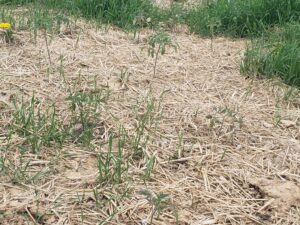 6.10.22 Tomatoes about 1 week post-planting
6.10.22 Tomatoes about 1 week post-planting
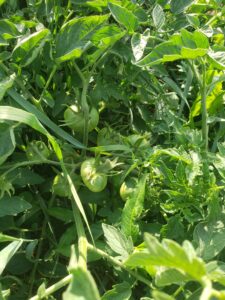 7.3.22 terra cotta tomatoes starting forming en masse
7.3.22 terra cotta tomatoes starting forming en masse
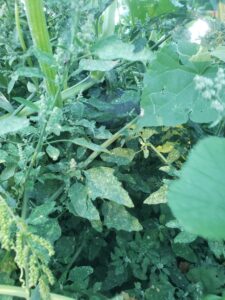 9.3.22 an acorn squash growing unbothered by heavy weed pressure
9.3.22 an acorn squash growing unbothered by heavy weed pressure
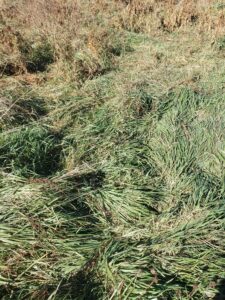 10.29.22 The aftermath of the pepper patch
10.29.22 The aftermath of the pepper patch
Notable tips/tricks:
- The temporary deer fence we used worked to keep wildlife out, and the electric fence was crucial for keeping livestock out. However, we were not able to reuse the deer fence due to weeds using them as a trellis. Weed control would be critical to ensuring the deer fence can be taken down without ripping and stored for the next year, otherwise it takes significant time to unweave a year's worth of weeds out of the 3" mesh.
- Planting with a drill auger was the most effective method we found for creating holes to transplant into.
- When the mulch is saturated, watering at planting is not entirely necessary. However, in some cases you may notice plants drying/withering several days later and a quick watering will resolve it. In general, though, watering at transplanting or seeding would increase survival rates.
- If the mulch is well-saturated, young transplants can be planted without disturbing the soil. We sometimes just grab a handful of wet bale residue, lift it up from the soil, put the plant down, then press the residue over the roots. Survival has been upwards of 75% with wet residue (e.g. when planting in the rain)
Observations/Recommendations by plant type:
- Basil: Marking the green varieties and proper weed control is vital. The large green leaves disappear quickly in the jungle of weeds in the nutrient-rich mulch
- Beans: Transplanting may be more effective than direct-seeding. However, with additional watering the seeds can be planted in the mulch without having to disturb the soil below
- Broccoli: Pest control is crucial to ensuring a marketable product. The weed pressure may have produced a better environment for pest populations to thrive. Also, we believe the nutrient-rich bale residue caused more vegetative growth and lower/slower yields
- Cabbage: The nutrient-rich bale residue likely caused more vegetative growth and lower/slower yields. Additionally, the cabbage was planted along the western side of the residue patch and the weed growth around the perimeter was significant. Therefore, it is possible the lack of afternoon sun may have slowed growth also
- Carrot/Radish: Scattering the seeds along the surface of the residue was not advisable. While the carrots and radishes did grow, they tended to sprawl along the surface instead of growing down into a traditional shape. The radishes were more "normal" than the carrots. Planting into the soil then covering with mulch may have worked better
- Corn: Weed control up to and through pollination is critical to ensure cobs are fully pollinated. The plants in May bale residue performed much better than the plants in March bale residue, likely for this reason. Also, it took longer for the soil to reach 60-65F which resulted in corn reaching market months later than local competitors
- Cucumber: Moisture held by the mulch seemed to adversely affect the cucumber plants, so these are not recommended without a trellis system or very well-drained soils
- Eggplant: Weed control was the largest factor for ensuring production
- Huckleberry: Critical to wait until after all risk of frost before transplanting
- Kalette/Brussels Sprouts: Nutrient-rich soil/bale residue produced very large and vegetative plants, so these probably aren't the most effective use of the space
- Kohlrabi: Transplanting would likely be more effective than direct-seeding, although these may also follow the trend of having too much nutrition to yield properly
- Okra/Sunflowers: It may be more critical to ensure the soil has warmed adequately before planting these. In the upper midwest, the season may not be long enough for some varieties to mature after the soil has warmed under the mulch
- Peas: The volunteer peas from the bales performed very well, so we are not sure why the direct-seeded varieties did not perform as well. Direct-seeding can be done with or without disturbing the soil under the mulch.
- Peppers: Planting at 12" spacing works well given the high nutrient content and water retention of the mulch. However, performance varies widely by variety with gypsy, emerald fire, and great stuff performing the best in our 3 years of trials. Poblanos failed to produce two years in a row.
- Pumpkin/Squash/Zucchini: Direct-seeding works very well and yields are very strong. Extremely simple to grow in bale residue.
- Tomatoes: Give the plants plenty of space because vegetative growth is significant. Trellising is more important for ease of harvest than for disease prevention. Water needs are significantly lower and unless the weather is very dry or the soil is very well drained, watering is not advised due to blossom end rot potential.
- Tomatoes pt. 2: Typically, tomatoes grown without trellises or pruning would have significant leaf blight and other signs of disease. However, our tomatoes didn't have any signs of disease on the plants. The two reasons we identified for this were: grass/weeds were helping support/trellis the tomatoes, and the soil was covered in a mulch which prevented soilborne diseases from transferring to the plants.
- Watermelon: Transplanting started plants has worked better than direct seeding. The challenge is not stepping on any of the vines that are hidden amongst the weeds
Project Outcomes
Several farmers at the field days were excited to see how healthy the tomato plants were as a result of the mulch preventing soilborne diseases. Indications were that they'd like to explore using mulch/bale residue for its health benefits for their tomato plants.
Future research should continue to explore the potentials of utilizing bale residue as mulch for labor savings and capitalizing on the limited weed growth. Our intention with this research was as an exploration of future possibilities and to acquire baseline knowledge that can set up other projects for success. Using the information from the learning outcomes above, future research could capitalize further on expanding best practices in specialty crop production. Furthermore, research could explore other uses for the bale residue in circumstances where appearance of end-product is less vital, or where moisture retention has fewer adverse consequences.
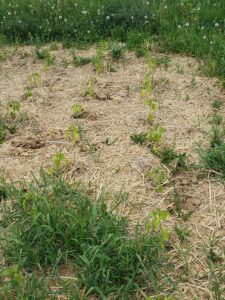 6.10.22 Peppers about 1 week post-planting. Note the yellow color indicating water stress--plants were watered briefly at planting with no subsequent rain during the week. This was the earliest bale grazing site, used in mid-January
6.10.22 Peppers about 1 week post-planting. Note the yellow color indicating water stress--plants were watered briefly at planting with no subsequent rain during the week. This was the earliest bale grazing site, used in mid-January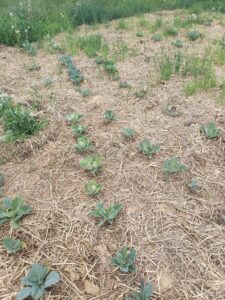 6.10.22 cabbage and brussels sprouts about 1.5 months post-planting. This was the last bale grazing site (besides the corn patch planted and pictured later), used in late April
6.10.22 cabbage and brussels sprouts about 1.5 months post-planting. This was the last bale grazing site (besides the corn patch planted and pictured later), used in late April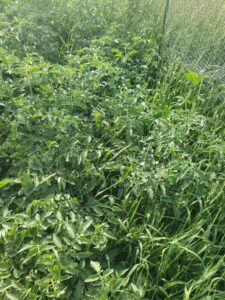 7.3.2022 tomatoes growing vigorously into each other without trellises, but no signs of leaf diseases
7.3.2022 tomatoes growing vigorously into each other without trellises, but no signs of leaf diseases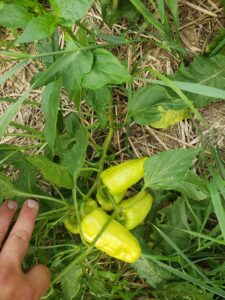 7.23.22 an example of a single gypsy plant producing 5 peppers at a time, they continued growing with our largest gypsy peppers being almost the size of a bell pepper at the store
7.23.22 an example of a single gypsy plant producing 5 peppers at a time, they continued growing with our largest gypsy peppers being almost the size of a bell pepper at the store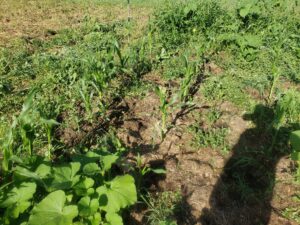 7.24.22 sweet corn rows popping up and sugar pumpkins coming in strong on the row ends. All were started from seed planted directly into bale residue. Germination date was very inconsistent with the sweet corn due to varying compaction from hoof marks, but germination was nearly 100% in the end
7.24.22 sweet corn rows popping up and sugar pumpkins coming in strong on the row ends. All were started from seed planted directly into bale residue. Germination date was very inconsistent with the sweet corn due to varying compaction from hoof marks, but germination was nearly 100% in the end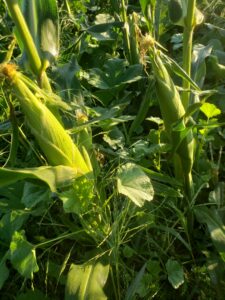 8.29.22 most corn stalks grown in the bale residue (used in May) produced two cobs. The sugar pumpkins grew in the lower canopy and were ~50% orange and ~50% green at the time of the photo
8.29.22 most corn stalks grown in the bale residue (used in May) produced two cobs. The sugar pumpkins grew in the lower canopy and were ~50% orange and ~50% green at the time of the photo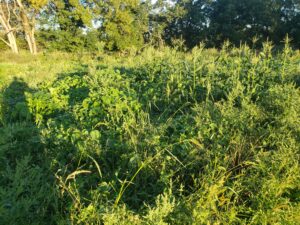 8.29.22 the bale residue site with zucchini on the left, wild violet sweet corn on the right, and acorn squash on the far side of the patch in the middle
8.29.22 the bale residue site with zucchini on the left, wild violet sweet corn on the right, and acorn squash on the far side of the patch in the middle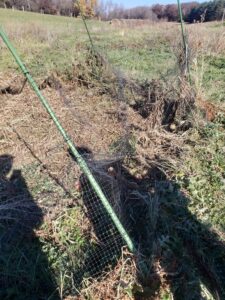 10.29.22 the aftermath of the tomato patch and an example of the condition of the "temporary deer fence" taken over by vining weeds and tomato vines
10.29.22 the aftermath of the tomato patch and an example of the condition of the "temporary deer fence" taken over by vining weeds and tomato vines